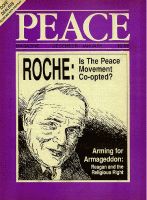
Peace Magazine Dec 1987-Jan 1988, page 9. Some rights reserved.
Search for other articles by Jennifer Ramsay here
EVENTS BEHIND THE COUPS IN FIJI HAVE BEEN overlooked in the North American media, though widely covered in the Australian and New Zealand press. After the first coup in May, the Sydney Morning Herald quoted a Pentagon source as saying "We're kinda delighted ... All of a sudden our ships couldn't go to Fiji, and now all of a sudden they can ...."
Fiji is once again free to station a U.S. base, and receive visits from vessels with nuclear weapons aboard. The U.S. Navy had a temporary setback this April when Timoci Bavadra brought the Labour Party to power with the National Federation Party to form the Coalition Party. He was to reinstate the anti-nuclear policy that had been in effect from 1978 to 1984. In 1984 Fiji's prime minister, Sir Rate Mara, reversed the ban on nuclear port visits. U.S. aid to Fiji was increased through programs like IMET (International Military Education and Training Program), PAMS (Pacific Armies Management Seminars) and the Weapons Standardization Program
Coup leader Rabuka claimed that the Coalition's government had been an Indian-dominated threat to Fijian interests, yet deposed Prime Minister Bavadra had appointed Fijians to top cabinet posts to avoid such accusations. Under the Fijian Constitution, which Rabuka suspended, Fijian power was secure, with reserved seats in the House of Representatives for 22 Fijians, 22 Indians and 8 general seats. Bavadra maintained that the coup had precipitated the racial tensions, not the other way around. Fijian language newspapers claimed Rabuka was saving. Fiji from a Libyan and communist takeover -- less extreme stories of Libyan and Soviet activity in the South Pacific soon appeared in dailies.
U.S. involvement in Fijiian affairs is no secret. What is less clear is whether the CIA is responsible for both coups. The evidence of intense activity is convincing, though circumstantial. See the June 1987 edition of the Wellington Confidential for a thorough history of U.S. involvement.
Between the election that brought in an anti-nuclear Coalition Party and the coup, U.S. General Vernon Walters met with the new Prime Minister and the military. He also met with Mara, who had just returned from a meeting in Honolulu with U.S. military and "development" men. The various U.S. "development" agencies operating in the Pacific are, at best, coercive in setting the direction in which a nation is to develop. According to a London magazine, Walters joked then of how wherever he went, a coup followed. Very funny: Iran, 1953; Brazil, 1964; Chile, 1973.
The Taukei movement, associated with the former Alliance party, suddenly sprang to life between May 14 and September 25 with firebombings, murders, and intimidation of the Indian population. At a press conference in Washington, Bavadra claimed that the U.S. Agency for International Development (AID) Director in Fiji, William Paupe (who many claim is a CIA agent), had paid $200,000 to create this "movement," Just before the coup Bavadra had made these allegations public.
The Americans and the French protect their turf in which to station bases and test nuclear weapons. A murder in Belau [see Disarmament Campaigns] and the use of three different types of troops to put down a "labour dispute" in Tahiti (dockworkers were protesting nuclear ships) in October, and mysterious Libyans in Vanuatu are all part of the fight to vanquish the spectre of a nuclear-free and independent South Pacific. The U.S. may or may not have directed the coup in Fiji, but I wonder how many months go by before a new base is announced?

Peace Magazine Dec 1987-Jan 1988, page 9. Some rights reserved.
Search for other articles by Jennifer Ramsay here